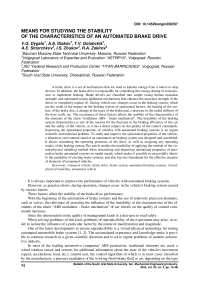Means for studying the stability of the characteristics of an automated brake drive
Автор: Dygalo V.G., Diakov A.S., Golubchik T.V., Smorchkov A.E., Zhukov I.S., Zakirov R.A.
Рубрика: Контроль и испытания
Статья в выпуске: 2 т.22, 2022 года.
Бесплатный доступ
A brake drive is a set of mechanisms that are used to transfer energy from a source to stop devices. In addition, the brake drive is responsible for controlling this energy during its transmission to implement braking. Brake drivers are classified into simple (using human muscular strength) and automated (using additional mechanisms that enhance the muscular strength of the driver or completely replace it). During vehicle use, changes occur in the braking system, which are the result of the impact on the braking system of operational factors: the beating of the surface of the brake disc, a change in the mass of the brake pad, a decrease in the radial stiffness of the hose walls, etc. The occurrence of these factors affects the stability of the characteristics of the elements of the chain “modulator ABS - brake mechanism”. The instability of the braking system characteristics is one of the reasons for the decrease in the braking efficiency of the car and the safety of the vehicle, as it has a direct impact on the quality of the control commands. Improving the operational properties of vehicles with automated braking systems is an urgent scientific and technical problem. To study and improve the operational properties of the vehicle, a laboratory semi-natural stand of an automated car braking system was designed and assembled. It allows simulating the operating processes of the drive, as well as assigning any operating modes of the braking system The article studies the possibility of applying the method of the virtual-physical modeling method when researching and improving operational properties of automotive brake automated systems on model stands, which makes it possible to successfully identify the instability of existing brake systems, and also lays the foundation for the effective creation of elements of unmanned vehicles.
Transport vehicle, brake drive, brake system, automated braking systems, virtual-physical modeling, unmanned vehicle
Короткий адрес: https://sciup.org/147238123
IDR: 147238123 | DOI: 10.14529/engin220207
Список литературы Means for studying the stability of the characteristics of an automated brake drive
- Kotiev G.O., Diakov A.S. Advanced development and testing of off-road vehicle. DEStech Transactions on computer science and engineering., 2017, pp. 464-467. DOI 10.12783/dtcse/cmee2017/20021.
- Kotiev G.O., Padalkin B.V., Kartashov A.B., Dyakov A.S. Designs and development of Russian scientific schools in the field of cross-country ground vehicles building. ARPN Journal of Engineering and Applied Sciences. 2017, vol. 12, no. 4, pp. 1064-1071.
- Dygalo V.G., Zhukov I., Diakov A., Chutkov K. Experimental evaluation of the effect of cryogenic treatment of brake discs of the vehicle on the performance characteristics. IOP Conference Series: Materials Science and Engineering. 2020, vol. 820, Number article 012004. DOI: https://doi.org/10.1088/1757-899X/820/1Z012004.
- Dygalo V.G., Lyashenko M.V., Potapov P.V. Ways for Improving Efficiency of Computer Vision for Autonomous Vehicles and Driver Assistance Systems. International Conference on Industrial Engineering, Applications and Manufacturing (ICIEAM), 2019, pp. 1-5, doi: 10.1109/ICIEAM.2019.8743060.
- Yang J., Dang R., Luo T., Liu J. The development status and trends of unmanned ground vehicle control system. IEEE Int. Conf. on Cyber Technology in Automation Control and Intelligent Systems, 2015, pp. 1946-1952. doi: 10.1109/CYBER.2015.7288245.
- Park J., Lee J-H., Son S.H. A Survey of Obstacle Detection Using Vision Sensor for Autonomous Vehicles, Int. Conf. on Embedded and Real-Time Computing Systems and Applications, 2016, pp. 264-264. doi: 10.1109/RTCSA.2016.54.
- Ranft B., Stiller C. The Role of Machine Vision for Intelligent Vehicles. IEEE Transactions on Intelligent Vehicles, 2016, vol. 1, no. 1, pp. 8-19.
- Bengler K., Dietmayer K., Färber B., Maurer M. Three decades of driver assistance systems -review and future perspectives. IEEEIntell. Transp. Syst. Mag., 2014, vol. 6, no. 4, pp. 6-22.
- Yoshimura T., Takagi A. Pneumatic active suspension system for a one-wheel car model using fuzzy reasoning and a disturbance observer Journal of Zhejiang University SCIENCE, 2004, vol. 5, pp.1060-1068.
- Howard D., Dai D. Public Perceptions of Self-Driving Cars: The Case of Berkeley, California. Transportation Research Board 93rd Annual Meeting, Washington DC, 2014, pp. 1-16.
- Payre W., Cestac J., Delhomme P. Intention to use a fully automated car: attitudes and a priori acceptability. Transport. Res. F: Traffic Psychol. Behav. 2014, vol. 27, pp. 252-263.
- Albatlan S. Automotive brake pipes characteristics and their effects on brake performance. Ain Shams Engineering Journal, 2012, vol. 3, pp. 279-287.
- Segal L. Diagnostic method for vehicle brakes. Ndt & E International, 1999, vol. 32, pp.369-373.
- Chen H., Gong X., Hu Y., Liu Q., Gao B., Guo H. Automotive control: The state of the art and perspective. Acta Autom. Sin. 2013, vol. 39, pp. 322-346.
- He R., Feng H. Research and development of autonomous emergency brake (AEB) technology. J. Automot. Saf. Energy, 2019, vol. 10, pp. 1-5.
- Nakata D., Okano T., Fukasawa T. Brake Apparatus Brake Control Unit and Brake Control Method. U.S. Patent 8303046B2, 2012, 13 p.
- Shen C., Wang J., Lin Y. Study on brake actuator of electro-mechanical braking system. Trans. Chin. Soc. Agric. Mach. 2007, vol.38, pp. 30-33.
- Li J., Yang K., Tan S. The Electro-Mechanical Brake Actuator of Using in Vehicle. CN Patent 201212535Y, 2009.
- Hu D., He R., Xu X., Yi F. Analysis on influencing factors of energy consumption characteristics of electronic hydraulic braking system. J. Beijing Inst. Technol. 2018, vol. 38, pp. 261-266.
- Lin H., Zhuo G. Electro-hydraulic brake system model identification. J. Jilin Univ. Eng. Technol. Ed. 2011, vol. 41, pp. 70-73.


